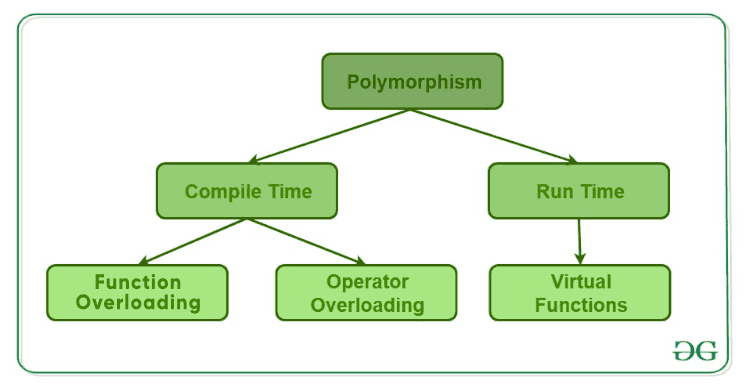多态性这个词的意思是有多种形式。简单地说,我们可以将多态性定义为一条消息以多种形式显示的能力。一个现实生活中的多态性例子,一个人在同一时间可以有不同的特征。像男人一样,同时也是父亲、丈夫和雇员。所以同一个人在不同的情况下有不同的行为。这叫做多态性。多态性被认为是面向对象编程的重要特征之一。
null
C++中的多态性主要分为两类:
- 编译时多态性
- 运行时多态性

多态类型
- 编译时多态性 :这种多态性是通过函数重载或运算符重载实现的。
- 函数得载 :当有多个同名但参数不同的函数时,这些函数称为 超载 .函数可以通过 参数数量的变化 或/和 参数类型的变化 . 函数重载规则
// C++ program for function overloading#include <bits/stdc++.h>usingnamespacestd;classGeeks{public:// function with 1 int parametervoidfunc(intx){cout <<"value of x is "<< x << endl;}// function with same name but 1 double parametervoidfunc(doublex){cout <<"value of x is "<< x << endl;}// function with same name and 2 int parametersvoidfunc(intx,inty){cout <<"value of x and y is "<< x <<", "<< y << endl;}};intmain() {Geeks obj1;// Which function is called will depend on the parameters passed// The first 'func' is calledobj1.func(7);// The second 'func' is calledobj1.func(9.132);// The third 'func' is calledobj1.func(85,64);return0;}输出:
value of x is 7 value of x is 9.132 value of x and y is 85, 64
在上面的示例中,一个名为 func 在三种不同的情况下表现不同,这是多态性的特点。
- 运算符重载 C++还提供了对过载操作符的选项。例如,我们可以使string类的运算符(“+”)连接两个字符串。我们知道这是加法运算符,其任务是将两个操作数相加。因此,在整数操作数之间加一个运算符“+”,在字符串操作数之间连接它们。 实例 :
// CPP program to illustrate// Operator Overloading#include<iostream>usingnamespacestd;classComplex {private:intreal, imag;public:Complex(intr = 0,inti =0) {real = r; imag = i;}// This is automatically called when '+' is used with// between two Complex objectsComplex operator + (Complexconst&obj) {Complex res;res.real = real + obj.real;res.imag = imag + obj.imag;returnres;}voidprint() { cout << real <<" + i"<< imag << endl; }};intmain(){Complex c1(10, 5), c2(2, 4);Complex c3 = c1 + c2;// An example call to "operator+"c3.print();}输出:
12 + i9
在上面的示例中,运算符“+”重载。运算符“+”是一个加法运算符,可以将两个数(整数或浮点)相加,但这里的运算符用于执行两个虚数或复数的加法。要详细了解运算符重载,请访问 这 链接
- 函数得载 :当有多个同名但参数不同的函数时,这些函数称为 超载 .函数可以通过 参数数量的变化 或/和 参数类型的变化 . 函数重载规则
- 运行时多态性 :这种多态性是通过函数重写实现的。
- 函数重写 另一方面,当派生类定义了基类的一个成员函数时,就会发生这种情况。这个基函数被称为 压倒 .
// C++ program for function overriding#include <bits/stdc++.h>usingnamespacestd;classbase{public:virtualvoidprint (){ cout<<"print base class"<<endl; }voidshow (){ cout<<"show base class"<<endl; }};classderived:publicbase{public:voidprint ()//print () is already virtual function in derived class, we could also declared as virtual void print () explicitly{ cout<<"print derived class"<<endl; }voidshow (){ cout<<"show derived class"<<endl; }};//main functionintmain(){base *bptr;derived d;bptr = &d;//virtual function, binded at runtime (Runtime polymorphism)bptr->print();// Non-virtual function, binded at compile timebptr->show();return0;}输出:
print derived class show base class
要详细了解运行时多态性,请访问 这 链接
- 函数重写 另一方面,当派生类定义了基类的一个成员函数时,就会发生这种情况。这个基函数被称为 压倒 .
本文由 严酷的阿加瓦尔 .如果你喜欢GeekSforgek,并想贡献自己的力量,你也可以使用 写极客。组织 或者把你的文章寄去评论-team@geeksforgeeks.org.看到你的文章出现在Geeksforgeks主页上,并帮助其他极客。
如果您发现任何不正确的地方,或者您想分享有关上述主题的更多信息,请写下评论。
© 版权声明
文章版权归作者所有,未经允许请勿转载。
THE END


![关于”PostgreSQL错误:关系[表]不存在“问题的原因和解决方案-yiteyi-C++库](https://www.yiteyi.com/wp-content/themes/zibll/img/thumbnail.svg)



